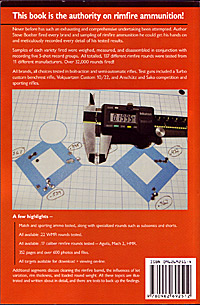The Rifleman's Guide To Rimfire
Ammunition - Steven Boelter
Book Review by: Andy Moe
A two year, thirty-two thousand round, three-hundred
fifty-two page Labor of Love.
You won’t be more than a few pages into Steve
Boeltzers new book, “The Rifleman’s Guide To Rimfire Ammunition”
to realize that the author put every minute of spare time and all
his energies into the writing of this book. You just can’t miss
it. This guy loves rimfires, and coming from a back ground of precision
BR competition and rimfire varminting, he was well equipped to handle
the subject. Steve’s enthusiasm for the sport runs unbridled
in his writing. It seeps into the discussion even when he’s
detailing the cheapest, bargain basement .22 round Wal Mart sells.
It’s difficult for a hardcore rimfire enthusiast like myself
to avoid getting swept up in it all. I read The Guide in two days.
Needless to say, I liked this book. Not only is the
printing of first class quality -with sharp text and clear photographs-
but the author also spared no expense in testing nearly a 100 different
varieties of ammunition from more than a dozen manufacturers. His
test rifles ranged from custom barreled 10/22’s to specialized
Turbo match bench rest rifles. Expansion tests, velocity tests, and
dimensional measurements are made of each cartridge tested. Whether
it’s Hornady’s 17HMR, Eley’s Tenex, or the bulky-boxed
Winchester 22LR ammo available from your local chain store, Steve
gives each exactly the same level of consideration and appropriately
analyzes its performance in the light of usage and cost effectiveness.
The data is thoroughly gathered and the presentation to the reader
well organized. If I liked nothing else about the book, the data alone
would earn him an “A” for Effort. He certainly put in
the work.

Steve’s zeal for the rimfire sports extends
beyond just his facts and figures. He graciously added additional
chapters sharing his experiences with different styles of chambers,
chambering reamers, and barrel tuners to expand the reader’s
understanding of the relationship between the rifle and the ammunition
available for it. Chapters on sorting ammunition by rim thickness
and weight are most enlightening and illustrate the author’s
tireless approach to experimentation. There is even a section on proper
cleaning technique –always a hot topic of debate amongst rimfire
devotees- and one I think (thankfully) the author has finally put
to rest. These extra chapters are icing on the cake for those who
took the title of his book verbatim.
It has often been said that Critics just don’t
feel they’ve earned their keep if they say only good things
about their victim, and as much as I liked The Guide, I do need to
mention a couple of minor issues. If I was to suggest a change in
Steve’s method I would have hedged towards addressing ammunition
performance in a larger variety of common rifles, and preferably those
more in the working man’s price range. One would expect a Turbo
BR custom to shoot excellent groups with match ammo. What would have
been more illuminating would be to see how various match ammunition
performs in the likes of a Marlin 980, or even a Ruger 77/22 or CZ
453 bolt guns. Of course, by necessity Steve was unable to fire all
varieties of ammunition in all of his rifles; most Sporting ammunition
just won’t fit into a Match chamber. Match ammunition however,
will generally fire in all Sporting chambers. To have done so would
have been a way of expanding the data base of each cartridge while
providing a glimpse of potential performance for the casual shooters
tempted to spend an hour’s wage on that box of Eley Tenex they’ve
had their eye on. What about that Micro Groove rifling, anyhow? Does
it really have any advantages in rimfire guns? One of the great attractions
of rimfire shooting is that often, common rifles can be pared with
common ammunition to give uncommon results. Coming from the no-compromise
world of precision shooting it’s easy to understand how Steve
insisted on shooting the best rifles he had available to him. He was
simply giving us our money’s worth. As it was this book was
massive undertaking and obviously required much work and forethought;
to cover every contingency would have been impossible. You just have
to draw the line someplace.
Ah! But this criticism stems from my own personal
wants. I could find no faults in the data or his technique. The only
hard faults I found in the book are a couple of minor typos that I’m
sure will be tidied up when Steve sets himself to the task of writing
the next edition to The Guide.
-And I’m certain he will need to write another
edition. The world of Rimfire changes every year. New cartridges and
trends will certainly send Steve packing to the range again. At least
I hope it does, and when the next edition comes out I’ll be
sure to buy it. “The Rifleman’s Guide to Rimfire Ammunition”
is worth the read. Got a rimfire? Get The Book. You’ll learn
something.
-- Andy Moe
Editor's Note:
Andy Moe has been writing for many years on a variety
of topics in the JHO
Gunroom . As one of the testers of the .17 Aguila (now the .17
PMC), he has extensive knowledge of rimfires and their use in the
field.
© 1999 - 2010 Varminter.com Online Magazine



